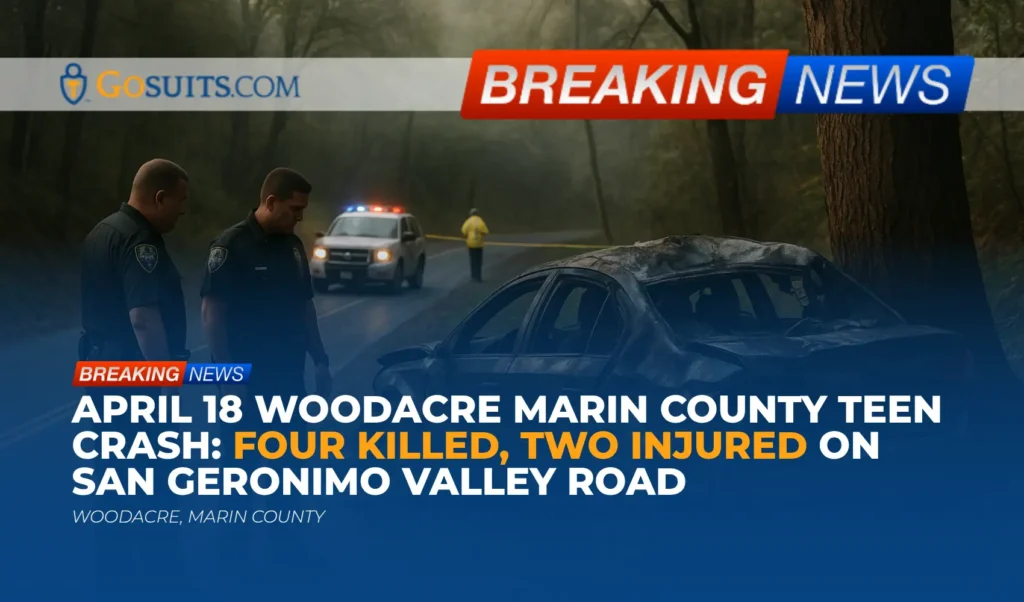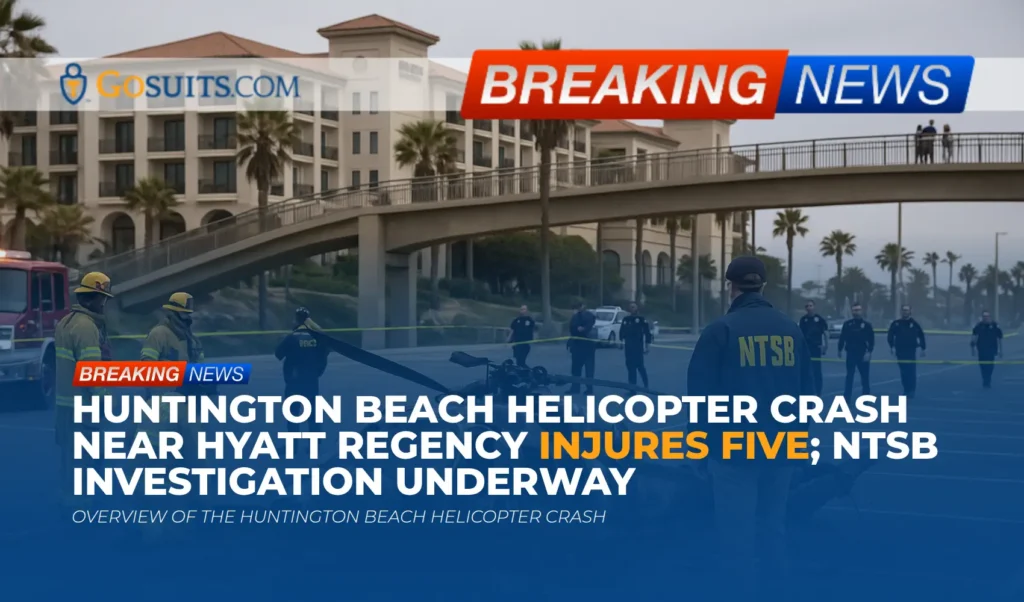- What we know about the two-vehicle crash near Kempner
- Where and when the crash occurred
- Who was involved
- Official reports and investigation status
- Safety context: U-turns from the shoulder and side-impact risks
- Legal perspective in Texas: duties, fault, and potential claims
- Insurance considerations and safeguarding rights
- How to get key records and where to call
- Practical steps to preserve evidence and timelines
- Special considerations when minors are injured
- Community care and roadway safety reminders
- Commentary from Gosuits Kempner, Texas Personal Injury Attorney
- Action steps to consider now
What we know about the two-vehicle crash near Kempner
A tragic two-vehicle collision occurred on US 190 in Lampasas County on Sunday morning, resulting in the death of a 51-year-old Belton woman and serious injuries to several others. According to the Texas Department of Public Safety, the crash happened at approximately 9:59 a.m. near mile marker 546, just outside Kempner. Preliminary information indicates the woman had stopped a 2010 Ford Edge on the westbound shoulder of US 190 and then attempted a U-turn to head eastbound. During this maneuver, her vehicle entered the path of a westbound 2008 Ford Explorer, which struck the Ford Edge on the driver’s side. The woman was pronounced deceased at the scene.
Two 13-year-old passengers in the Ford Edge were airlifted to McLane Children’s Hospital in Temple with serious injuries. The driver of the Explorer, a 65-year-old man from Copperas Cove, and his 65-year-old female passenger were transported by ambulance to AdventHealth Central Texas in Killeen, also with serious injuries. Authorities stated that next-of-kin notifications have been made.
At this time, the account provided reflects initial details released by state authorities. Investigators typically continue to gather and analyze evidence in the days and weeks after a serious crash, which can include scene measurements, vehicle inspections, and witness statements, among other steps.
Where and when the crash occurred
The collision took place on US Highway 190 in Lampasas County, Texas, about a mile marker 546 location near Kempner. The reported time of the incident was 9:59 a.m. on a Sunday. US 190 is a multi-lane corridor in this region, carrying both local and through traffic, including weekend travel. The precise roadway configuration at the exact point of impact was not provided in the public summary, but the mention of a shoulder stop and attempted U-turn suggests an area with enough shoulder width to pull over, followed by a maneuver across travel lanes.
Who was involved
Based on the public report:
- Decedent: A 51-year-old woman from Belton driving a 2010 Ford Edge. She was pronounced deceased at the scene after a driver-side impact.
- Passengers in the Ford Edge: Two 13-year-old minors, a boy and a girl, were airlifted with serious injuries to a Temple children’s hospital.
- Other vehicle: A 2008 Ford Explorer driven westbound by a 65-year-old man from Copperas Cove with a 65-year-old female passenger. Both were transported by ground ambulance to a Killeen hospital with serious injuries.
No further identifying details about the minors or the hospitalized occupants were made public in the initial report beyond their ages and injury status. Updates on conditions typically come later if families choose to share them or if official reports are released.
Official reports and investigation status
The Texas Department of Public Safety announced that next of kin had been notified. In crashes such as this, DPS troopers and crash reconstruction teams often conduct a detailed scene investigation, which may involve skid-mark analysis, vehicle damage profiling, time-distance calculations, visibility considerations, and review of any available dashcam or surveillance footage. The final crash report is generally released to eligible requestors after it is completed and processed in the state system.
Under Texas law, crash reports are maintained and released according to statutory rules. Members of the public who qualify under the statute may obtain the report through the state’s Crash Records Information System. Texas Transportation Code governs the release of crash reports, including Section 550.065, which outlines who can access them and how. The purchase portal for Texas crash reports is available through TxDOT’s CRIS.
Safety context: U-turns from the shoulder and side-impact risks
U-turns are among the more complex maneuvers on the roadway because they require a driver to evaluate oncoming traffic speed and distance, roadway geometry, sightlines, and the time needed to complete the turn safely. The Texas Driver Handbook, published by the Department of Public Safety, emphasizes that drivers should only make a turn when it is safe to do so, should signal in advance, and must not turn in a manner that interferes with other traffic’s right-of-way. It also cautions against U-turns on hills, curves, or where visibility is limited or signs prohibit such maneuvers. These principles underscore the general rule that a driver must ensure the path is clear before turning across or into lanes of travel. Guidance on safe turning and signaling is available from the Texas DPS Driver Handbook.
Additionally, side-impact collisions often result in severe injuries because the struck vehicle’s side structure has less crush space than the front or rear. National roadway safety agencies have long noted the high risk of serious injury in side impacts. For general information about side-impact safety concerns and occupant protection, see NHTSA’s side-impact safety page.
Stopping on the shoulder also presents hazards. Re-entering traffic or making a turn from the shoulder requires a careful assessment of gap acceptance, signaling, and yielding to oncoming vehicles. Even small errors in timing can have grave outcomes at highway speeds.
Legal perspective in Texas: duties, fault, and potential claims
While each collision must be evaluated on its own facts and evidence, several legal concepts in Texas civil law commonly arise in a crash like this:
- Duty to make safe turns and yield as required: Drivers owe a duty to operate their vehicles with reasonable care, which includes signaling and ensuring a turn can be made safely without impeding oncoming traffic. The DPS Driver Handbook reiterates that drivers must not start, stop, or turn unless they can do so safely and must use turn signals appropriately. These safety rules inform how negligence may be evaluated.
- Right-of-way considerations: A vehicle traveling straight in a lane of through traffic typically has the right-of-way over a vehicle turning across that lane. If a driver turns across oncoming lanes from the shoulder, a central question is whether that turn could be completed safely given the distance and speed of approaching traffic.
- Comparative fault (proportionate responsibility): Texas follows proportionate responsibility. If more than one person’s conduct contributed to a crash, a jury can allocate percentages of responsibility. A claimant found to be more than 50 percent responsible is barred from recovery, and a claimant found 50 percent or less responsible may recover reduced damages proportionate to their fault. This is set forth in Texas Civil Practice and Remedies Code § 33.001.
- Wrongful death and survival claims: When a death occurs, Texas law allows certain family members to bring a wrongful death claim and permits the decedent’s estate to pursue a survival claim for damages the decedent could have claimed had they lived. These causes of action are governed by Texas Civil Practice and Remedies Code Chapter 71.
- Claims for injured passengers and occupants: Injured passengers, including minors, may have personal injury claims against any at-fault parties. Their claims can include medical expenses, pain and suffering, physical impairment, and other legally recognized damages, subject to proof.
- Statutes of limitation: Most Texas personal injury and wrongful death claims must be filed within two years of the incident. See Texas Civil Practice and Remedies Code § 16.003. Certain circumstances can affect timing, including tolling for minors under § 16.001, so it is important to review deadlines early.
Evidence that can influence responsibility determinations may include dashcam footage, any nearby surveillance video, event data recorder downloads, 911 audio, scene diagrams and measurements, vehicle inspections, and eyewitness statements. Weather, sightlines, and speed can also play important roles. Families and injured individuals often benefit from preserving and collecting key records promptly.
Insurance considerations and safeguarding rights
After a serious crash, insurance companies typically move quickly. Adjusters for different parties may call to request recorded statements, authorizations, or medical releases. Those conversations can have long-term consequences for a claim’s valuation and liability assessment.
- Speak with a qualified attorney before engaging insurers: It is prudent to obtain a free consultation with a personal injury attorney before giving any recorded statement or signing any documents. What someone says to an insurance company can be used against them later, and early decisions on authorizations or statements may affect fault determinations and compensation assessments.
- Multiple insurance policies may apply: Potential coverages could include the at-fault driver’s liability policy, underinsured or uninsured motorist coverage, personal injury protection (PIP), medical payments coverage, and various health insurance benefits. In wrongful death cases, additional issues can arise regarding estate claims and beneficiaries.
- Do not rush to accept the first offer: Early offers may not reflect the full scope of losses, especially when injuries are still being evaluated or when long-term care needs are unknown.
- Document everything: Keep copies of medical bills, transport invoices (air and ground), prescriptions, therapy referrals, and all correspondence with insurers. This documentation supports the claim and helps track out-of-pocket losses.
How to get key records and where to call
In the days after a serious collision, having the right records can bring clarity and help with insurance and legal processes. The following are common records and where they can usually be obtained in Texas:
Crash report (Texas Peace Officer’s Crash Report)
Texas crash reports are maintained through the Texas Department of Transportation’s Crash Records Information System (CRIS). Eligible requestors can purchase a certified copy online once the report is filed.
- Where to request: TxDOT CRIS Purchase Portal
- Legal framework: Access and release are governed by Transportation Code § 550.065.
- What you may need: Date of crash, location (US 190 near mile marker 546, just outside Kempner, Lampasas County), names of involved parties if known, and the investigating agency (Texas Department of Public Safety).

Autopsy or inquest records
In many Texas counties, if there is no medical examiner’s office, a Justice of the Peace conducts inquests and may order an autopsy under the Texas Code of Criminal Procedure Chapter 49. The inquest record and autopsy report, if performed, are typically maintained by the county authority overseeing the inquest.
- Who to contact: The Lampasas County Justice of the Peace office that handled the inquest, or the county authority designated for inquest records. Procedures derive from Texas Code of Criminal Procedure Chapter 49.
- What to ask: Whether an autopsy was ordered, where it was performed, availability of the report, and what documentation is needed to request copies.
Death certificate
Certified death certificates for deaths occurring in Texas are issued through the Texas Department of State Health Services (DSHS) Vital Statistics. Funeral homes often assist, but direct requests are possible through the state.
- Where to request: Texas DSHS Vital Statistics: Death Records
- What to prepare: Proof of identity and eligibility, fees, and details such as the decedent’s name, date of death, and location (Lampasas County).
Medical records and billing
Hospitals and transport providers maintain their own records. For this crash, records may exist with the receiving hospitals in Temple and Killeen, as well as with air medical services and ground EMS agencies involved.
- Who to contact: The hospital health information management (HIM) or medical records department, air ambulance provider, and local EMS provider. Provide patient name, date of service, and authorization if you are a legal representative.
- What to request: Emergency department records, imaging, physician notes, discharge summaries, itemized billing, and transport records.
Vehicle records and inspections
Impounded vehicles may be held by a tow company or storage facility. If a civil claim is anticipated, it is important to preserve the vehicles for inspection before they are repaired or destroyed.
- Who to contact: The investigating agency for the tow release information, then the tow/storage provider to request a hold. Consider promptly notifying all insurers and sending a written preservation request to avoid disposal.
Practical steps to preserve evidence and timelines
- Gather and preserve evidence immediately: Save photos, videos, and contact information for any witnesses. If there are businesses or residences near mile marker 546 on US 190 that may have cameras facing the roadway, footage could be time-sensitive.
- Request the official crash report as soon as it posts: Monitor the TxDOT CRIS portal for availability and obtain a certified copy.
- Keep a centralized file: Organize medical records, bills, proof of payments, mileage to appointments, and employment records documenting time missed from work.
- Note all deadlines: Texas generally allows two years to file injury and wrongful death claims (§ 16.003), though some claims have shorter notice requirements, and minors’ timelines may be tolled (§ 16.001).
- Coordinate with personal representatives: In a wrongful death matter, identify the appropriate personal representative or family members who have standing to request records and act on behalf of the estate or statutory beneficiaries, consistent with Chapter 71.
- Consult counsel early: Before any statements to insurers, consider a free consultation to understand rights and obligations. Early legal guidance can help protect evidence and avoid missteps.
Special considerations when minors are injured
In Texas, minors have important protections under the law. Their limitations periods are generally tolled until they reach the age of majority, under Texas Civil Practice and Remedies Code § 16.001. However, related claims for medical expenses incurred during minority are often brought by the parent or legal guardian, so practical timelines can still be immediate.
Hospitals may require consent from a parent or court-appointed guardian for release of minors’ medical records. In injury claims, any settlement involving a minor may require additional court oversight or approval to ensure the child’s interests are protected. Families often find it helpful to document the child’s symptoms, appointments, missed school, and any specialized care referrals to provide a full picture of recovery needs.
Community care and roadway safety reminders
Crashes like the one reported near Kempner reverberate across families, schools, workplaces, and neighborhoods. In the aftermath, community members often look for ways to reduce risk on the same corridors where they travel daily. While investigations will determine the specific factors in this crash, there are general roadway safety reminders that are consistently emphasized by state and national safety authorities:
- Only make U-turns where lawful and safe: Avoid U-turns on curves or hills where visibility is limited, and never turn across lanes unless you can do so without interfering with oncoming traffic. See the Texas DPS Driver Handbook for core turning and signaling guidance.
- Re-entering from the shoulder requires extra caution: Build sufficient speed in the shoulder where lawful and safe before merging, check mirrors and blind spots, and yield to traffic already in the lanes. If performing a turn from a stopped position, ensure a clear, adequate gap in both directions.
- Understand side-impact risk: Because side structures offer less protection, even moderate-speed impacts can be severe. NHTSA provides general information on occupant protection in side impacts: NHTSA Side Impacts.
- Seat belts and proper child restraints at all times: They remain the single most effective means of reducing serious injury and death in crashes.

Commentary from Gosuits Kempner, Texas Personal Injury Attorney
We are deeply saddened by the loss of life and the serious injuries reported in this collision near Kempner. Our hearts are with everyone affected, including the children and the families now navigating medical decisions, grief, and uncertainty. This commentary is intended for educational and general informational purposes only.
Based on the initial summary released by authorities, the crash appears to have occurred when a vehicle stopped on the shoulder attempted a U-turn into the path of a westbound SUV. Turning across lanes from a stopped position requires extraordinary care. Texas roadway safety guidance stresses that drivers should never start a turn unless it can be completed safely without interfering with other traffic, and U-turns should not be made on curves, hills, or where visibility is limited or prohibited. Investigators will evaluate sightlines, speeds, signaling, timing, and whether the maneuver could be made safely given approaching traffic. Side-impact dynamics also matter because they often result in severe injuries, especially to the struck driver’s side.
In the civil injury context, Texas uses proportionate responsibility. Different parties’ actions may be examined to determine each person’s share of fault. For injured passengers, especially minors, claims may proceed against any parties found negligent. For a fatality, the law provides a pathway for certain family members to bring wrongful death claims and for the decedent’s estate to bring survival claims. These are complex, and evidence preservation is essential: crash reports, medical records, scene documentation, and vehicle inspections can all shape the outcome.
Insurance companies and large corporations often act quickly after a serious crash. They may request recorded statements or broad medical authorizations before the full picture is known. That speed and information advantage can work against people who are still seeking care or awaiting official reports. Early statements can be misconstrued or taken out of context, and partial records can lead to premature decisions about fault and damages. Understanding rights, the types of coverage potentially available, and the long-term implications of any release or statement can help level the playing field.
Obtaining a free consultation before speaking with insurance adjusters can be an important step. It allows individuals to understand their options, the timelines involved, and the evidence needed to protect their interests. It also reduces the risk that something said in a stressful moment will be used later to minimize or deny a claim.
Action steps to consider now
- Secure official records promptly: Monitor and request the certified crash report through the TxDOT CRIS portal, and ask the appropriate county authority about inquest or autopsy documentation pursuant to Chapter 49. Early access to records informs decisions and helps with insurance filings.
- Preserve vehicles and evidence: If vehicles are in storage, request a hold to enable inspection. Identify potential nearby cameras along US 190 near mile marker 546. Many systems overwrite footage quickly, so time is critical.
- Organize medical information: Request itemized hospital and transport bills and maintain a treatment log. Consistent documentation supports recovery of out-of-pocket expenses and clarifies ongoing care needs.
- Consult before contacting insurers: Consider obtaining a free consultation to understand rights and strategy prior to any recorded statements or authorizations. Statements made to carriers can be used to challenge liability and damages later.
- Track deadlines and roles: Note the general two-year statute for injury and wrongful death claims in Texas (§ 16.003) and potential tolling for minors (§ 16.001). Clarify who can request records and make decisions on behalf of injured minors or an estate.
- Prioritize well-being: Serious trauma can involve ongoing medical care and emotional recovery. Follow medical advice, keep all appointments, and consider supportive services as recommended by treating providers.






